A City on a Hill
Road trips have become a regular thing in our retirement, but we rarely spring for luxury accommodations. When it came to our three days in Boston however, we didn’t want to spend part of each day stuck in traffic or fumbling through its public transit or parking regulations. We put on our walking shoes and strolled right out of our hotel lobby and into the city.
Click on the first photo in each group and scroll to see the square photos at full size.
To start at the beginning of this series, visit Fall for New England 2021.
 The Godfrey Hotel Boston
The Godfrey Hotel Boston
Although not a “big city” guy, Boston has been on Jim’s bucket list for years, given its historic past. We asked our timeshare group for suggestions on how they handled the expense vs. other scenarios which involved a commute.
It seemed almost everyone who replied had tried a different scenario. After all of the back and forth, we decided we wanted the flexibility to walk everywhere so we decided to bite the bullet and stay downtown.
After obsessing over the Boston maps – Boston Common, the Freedom Trail, The Boston Public Garden – we decided on the ultra-modern Godfrey Hotel because of its proximity to all of the above. Plus the photos on their website were beautiful!
We parked our car and left it for three days (which was also expensive) and we walked everywhere. Was the splurge worth it? Would we do it again? Yes we would!
Boston artist Mark Grundig painted this mural and more wall decor at Democracy Brewing. The saying “Ense petit placidam sub libertate quietem” translates to: “With the sword he seeks a peaceful repose in freedom.”
Just around the Corner
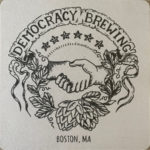 After a little stress on the freeway and a couple of wrong turns, we made it safely to the Godfrey. There was a parking spot right out front just for us and with the help of a very friendly valet, all of our “stuff” was effortlessly moved to our room. We unpacked a few things and relaxed for a bit until our tummies started rumbling for some dinner.
After a little stress on the freeway and a couple of wrong turns, we made it safely to the Godfrey. There was a parking spot right out front just for us and with the help of a very friendly valet, all of our “stuff” was effortlessly moved to our room. We unpacked a few things and relaxed for a bit until our tummies started rumbling for some dinner.
Since it was dark and we were in a new and bustling city, our decision was made quickly when we found Democracy Brewing just around the corner. It turned out to be a great introduction to the city with a beautiful bar, great food and really great beer!
In looking at their website, this business is democratically governed and worker-owned. It was fascinating to read the bios of the folks running this place, and it made the food and beer taste that much better.
We could have stayed for a little comedy after our meal in another area of the building, but instead we called it a night. It was a long day after stops in Lexington and Concord and we needed a good night’s sleep tonight to conquer Boston tomorrow. The heavenly bed at the Godfrey helped with that.
History 102
This Massachusetts Bay Colony was inhabited for centuries by Native Americans who called the area Shawmut. In 1614 Captain John Smith explored the coastline of “New England”. Shortly after, folks in search of religious freedom (the Pilgrims) arrived and named it Tremontaine (three hills). When a fleet of Puritan ships arrived in 1630 led by John Winthrop, its name was changed to Boston. “A city on a hill” described John Winthrop’s expectation that the colony would shine like an example to the world.
As a preamble, you really should watch this three-minute video on The French and Indian War (1756-1763) – one of the most consequential wars in American history.
Taxation without Representation
As Boston grew and prospered, tensions between colonists and English governors increased. A series of taxes to help recoup some of Britain’s debt after the French and Indian War only made matters worse.
- Stamp Act (1765) was the first tax levied directly on American colonists. The act would tax all paper documents in the colonies. Arguing that only their own representative assemblies could tax them, the colonists insisted that the act was unconstitutional. After they resorted to mob violence, it was repealed in 1766.
- Townshend Acts (1767) – Parliament again tried to assert its authority by passing legislation to tax goods that Americans imported from Great Britain. Americans struck back by boycotting British goods that were subject to taxation. In an effort to muffle the resistance, the British sent troops to occupy Boston. This only made matters worse.
- Boston Massacre (1770) – Tensions peaked one afternoon, when a disagreement led to a crowd of 200 colonists surrounding seven British troops. Americans began taunting and throwing things and the soldiers fired into the crowd. Although only five Bostonians lost their lives, the “massacre” became a useful propaganda tool for the colonists. It didn’t really matter that the British were not the aggressors in this case.
- The Boston Tea Party (1773) – The British eventually withdrew forces. They repealed many of the Townshend Acts (except the Tea Tax) and enacted the Tea Act. Giving the British East India Company favorable tax treatment, they could undercut American merchants who imported from Dutch traders. Bostonians responded by tossing more than 92,000 pounds of British tea into Boston Harbor.
- Coercive Acts (1774) – Many members of Parliament lost great sums of money when all that tea went into the harbor. They had invested heavily in the British East India Company since it seemed a sure thing. When their plan backfired, they decided to tame the rebellious colonists with these acts:
• Boston Port Act closed the port of Boston until damages from the Tea Party were paid.
• Massachusetts Government Act restricted Massachusetts democratic town meetings and turned the governor’s council into an appointed body.
• Administration of Justice Act made British officials immune to criminal prosecution in Massachusetts.
• Quartering Act required colonists to house and quarter British troops on demand, including in their private homes as a last resort.
You Know What They Say about Assuming
“Parliament hoped that the acts would cut Boston and New England off from the rest of the colonies and prevent unified resistance to British rule. They expected the rest of the colonies to abandon Bostonians to British martial law. Instead, other colonies rushed to the city’s defense, sending supplies and forming their own Provincial Congresses to discuss British misrule and mobilize resistance to the crown. In September 1774, the First Continental Congress met in Philadelphia and began orchestrating a united resistance to British rule in America.” ~ READ MORE
Many of the key events leading up to the Revolutionary War occurred in or near Boston and we are going to visit the locations of quite a few. We were at Concord and Lexington earlier today, which you can read at this link. At the link there is a current-day photo of the Old North Bridge, but the one just below looks cool with soldiers lined up on both sides of the Concord River.
Ed Vebell/Getty Images, from 7 Events That Enraged Colonists and Led to the American Revolution.
Walk Into History Tour
Looking out our hotel window was quite a treat this morning with an all-glass building reflecting the gorgeous clouds and beautiful blue sky. We could tell it was going to be a great day!
We met our guide at Boston Common at noon to begin our 2-1/2 hour tour. To be honest, when he introduced himself as Dr. Samuel Prescott, I wasn’t sure who he was supposed to be portraying. As I’ve said before, I’m not much of a history buff – but I may get a little reprieve from my ignorance, because I’ve been hearing about Paul Revere’s ride for years – with no mention of our beloved tour guide.
Our Tour Guide sets us Straight
According to Dr. Prescott, several things about the night of April 18 and Paul Revere’s ride weren’t quite on point. Patriot spies had caught wind that the British were coming from Boston to Lexington the next day (April 19, 1775) to capture rebel leaders John Hancock and Samuel Adams. Once that task was complete they would continue on to Concord to destroy the American weapons and ammunition that were stockpiled there. Paul Revere supposedly road through the streets and shouted: “The British are coming! The British are coming!”
Our tour guide stated that instead of shouting “The British are coming!” he would have shouted “The Regulars are Out!” and not because most Americans still considered themselves to be British, but because British soldiers were called Regulars (they were in the regular army). And, he would NOT have shouted at all! This is some serious spy stuff here, he had to be sneaky and quiet.
The Real Story goes…
According to “Historical Digression“:
Paul Revere and William Dawes (the two “Midnight Riders”) were alerted that spies had caught wind of a British strike on the provincial military supplies at Concord, and that about 800 Regulars had left Boston. Their mission was to warn John Hancock and Samuel Adams in Lexington, which they completed successfully. They were then instructed to continue on to Concord to alert the town.
Not far outside of Lexington, Revere and Dawes were met by the young Dr. Prescott and he joined in their task of alerting households and pushing on to Concord. Since Revere considered Prescott “a High Son of Liberty,” they trusted him to help with their crucial mission. Prescott was also well known in the area (being a country doctor) and would be helpful in assuring residents that this was all for real.
The three riders only made it about three miles (halfway to Concord) when they were detained by a British patrol on horseback. Dawes escaped and went back to Lexington, Revere was later released and walked back to Lexington, and Samuel Prescott escaped and made it to Concord. Along the way he alerted several more households in Lincoln. He arrived in Concord and the town bell was rung. Samuel Prescott had completed the mission given to him by Revere.
So when remembering Paul Revere’s ride, also remember William Dawes AND ESPECIALLY (our tour guide) Dr. Samuel Prescott.
Break Time
That was a lot of history (for me anyway). I’ll continue my next post with more pictures and fewer facts, for those of you who prefer that kind of stuff!
Next up: Walk into History
Happy trails,
Barb

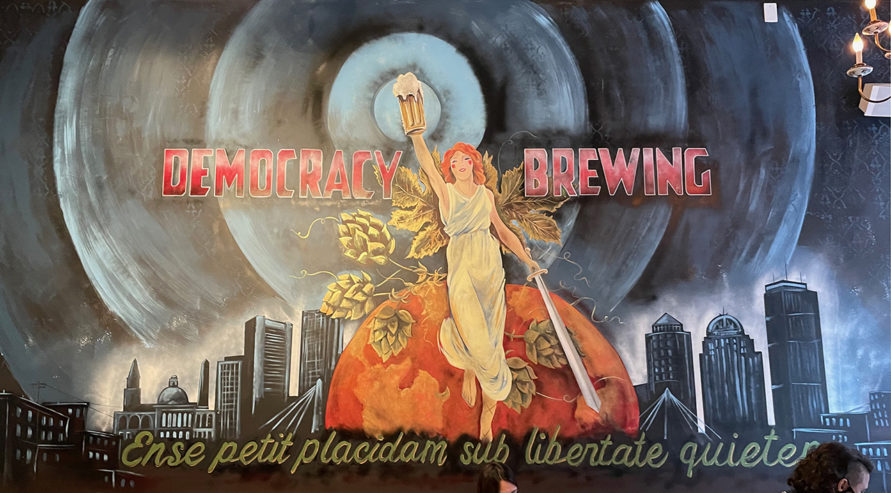


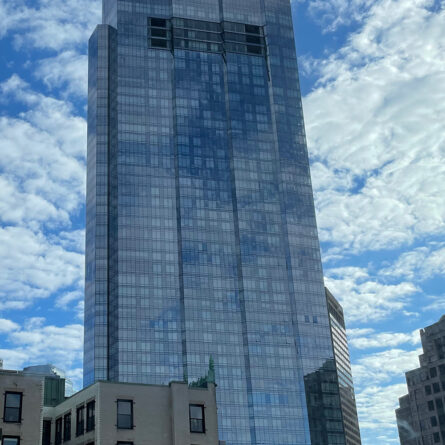
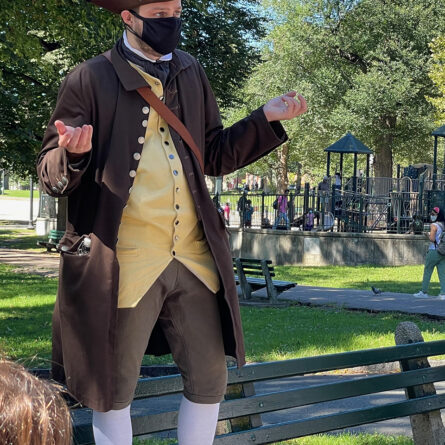

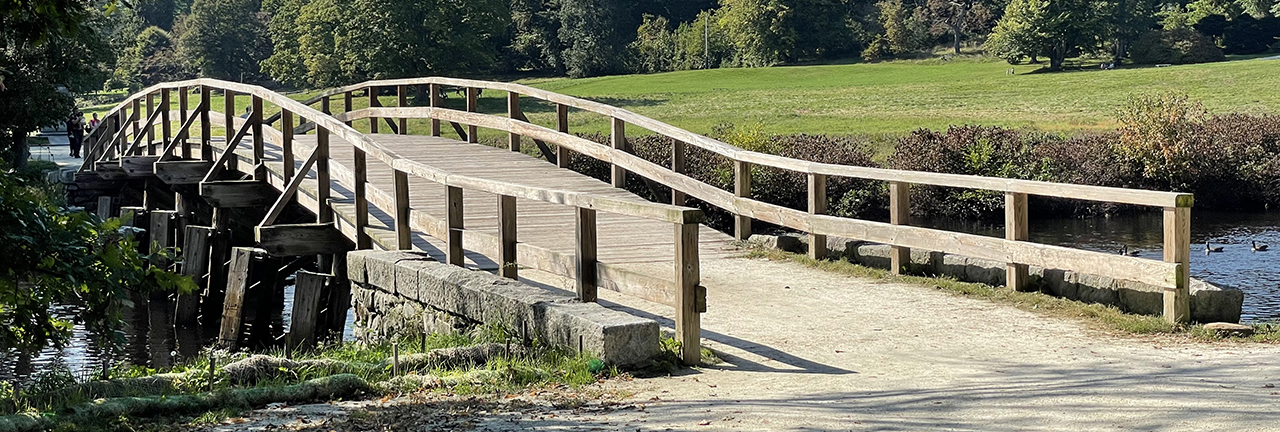




Comments are closed here.